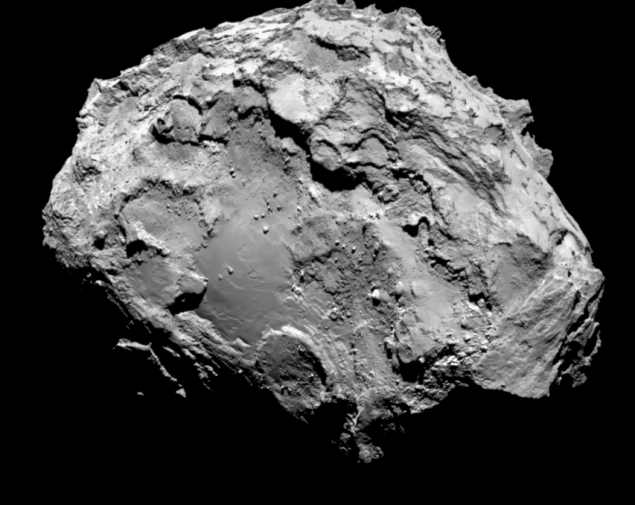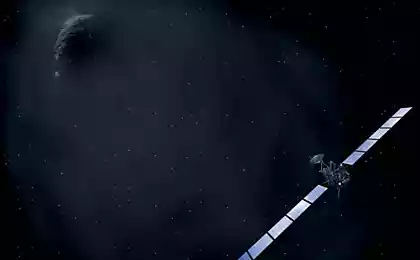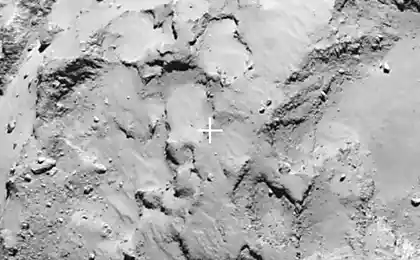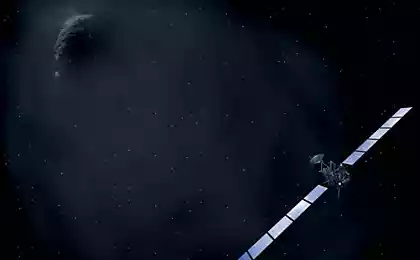1148
Meeting with the comet today
Two years ago, the incredible landing rover Curiosity on Mars, but today there is no less complex and important event in the solar system - the spacecraft Rosetta, after a ten-year trip, goes into orbit of the comet 67P / Churyumov-Gerasimenko.

I will try as quickly as possible to report on how this operation is 400 million kilometers from Earth.
Today, the distance between the probe and the nucleus of the comet will be reduced to 100 km, the unit will adjust the trajectory and starts its rotation around chetyrehkilometrovoy "dirty snowballs". Formally, this will not go into orbit, as comets do not have enough gravity to hold the Rosetta, but its trajectory provides this condition. The probe will fly in front of the comet, not to fall into her tail, where dust can cause damage to the device. The machine starts the slow convergence with the core rotating in the so-called "Triangular arcs." Each U-turn on this "orbit" will be performed as well by including the engines, but today will be the final correction of the trajectory closer to the comet.
Turning engines will take 6 minutes 26 seconds and begin at 13:00 Moscow time.
The distance to the probe causes a delay of data transmission in 22 minutes. Because of the difficulties in transmission, we can not watch the video of convergence, but images with the navigation camera will get as soon as possible.
Meanwhile, experts have prepared a demo ESA allowing imagine how it will look around the Rosetta comet mission.
This model has a fresh kernel, is based on images obtained in July.
The live broadcast will be on the website ESA . Although fear in the key moment the site will not sustain the influx of spectators.
I am now on the COSPAR Scientific Assembly at MSU, where there were about two thousand. Astronomy, planetary and astrophysicists from around the world. There will also be organized direct inclusion, so we will be able to receive information from virtually firsthand. Moreover, here there is the discoverer of Comet Churyumov Clim. I can not imagine what feelings he is experiencing at the moment. Did he think of something like 45 years ago when a comet reviewed the images captured by Svetlana Gerasimenko?
Rosetta has two sets of cameras: a navigation Navcam, animation which opens this material. And scientific camera OSIRIS, it has a more powerful lens (800 mm), which is about three times higher than the power Navcam.
Here's a snapshot of OSIRIS comet nucleus at a distance of 1 thousand. Km.

If today publish a picture with this camera, we see a comet in the highest resolution, the history of research.
At this point the speed of the comet and Rosetta is approximately 15 km 2 / s (55 thousand. Km / h), but with respect to each other their speed does not exceed 1 m / s. This is significantly different from any other research probe encounters with comets. Previously, vehicles approached with comets on a collision trajectory from which their speed summed and reach tens of kilometers per second. Ie about any close approach is not out of the question - dust from the comet's tail quickly disabling device or devices.
This is described in the form of art, cartoon from ESA:
Original
After 4 months will be held no less important event - landing on a comet lander Philae, but the success of this unprecedented operation depends on the day.
Stay tuned for updates.
More information about Rosetta can be found here: habrahabr.ru/post/211444/
UPD:
Showed images with OSIRIS, which are the most detailed image of the surface of the comet, but so far only ekranki:


Yes, we are in orbit!


Waiting for new pictures with Rosetta.
Oh, yeah!


Source: habrahabr.ru/post/232383/

I will try as quickly as possible to report on how this operation is 400 million kilometers from Earth.
Today, the distance between the probe and the nucleus of the comet will be reduced to 100 km, the unit will adjust the trajectory and starts its rotation around chetyrehkilometrovoy "dirty snowballs". Formally, this will not go into orbit, as comets do not have enough gravity to hold the Rosetta, but its trajectory provides this condition. The probe will fly in front of the comet, not to fall into her tail, where dust can cause damage to the device. The machine starts the slow convergence with the core rotating in the so-called "Triangular arcs." Each U-turn on this "orbit" will be performed as well by including the engines, but today will be the final correction of the trajectory closer to the comet.
Turning engines will take 6 minutes 26 seconds and begin at 13:00 Moscow time.
The distance to the probe causes a delay of data transmission in 22 minutes. Because of the difficulties in transmission, we can not watch the video of convergence, but images with the navigation camera will get as soon as possible.
Meanwhile, experts have prepared a demo ESA allowing imagine how it will look around the Rosetta comet mission.
This model has a fresh kernel, is based on images obtained in July.
The live broadcast will be on the website ESA . Although fear in the key moment the site will not sustain the influx of spectators.
I am now on the COSPAR Scientific Assembly at MSU, where there were about two thousand. Astronomy, planetary and astrophysicists from around the world. There will also be organized direct inclusion, so we will be able to receive information from virtually firsthand. Moreover, here there is the discoverer of Comet Churyumov Clim. I can not imagine what feelings he is experiencing at the moment. Did he think of something like 45 years ago when a comet reviewed the images captured by Svetlana Gerasimenko?
Rosetta has two sets of cameras: a navigation Navcam, animation which opens this material. And scientific camera OSIRIS, it has a more powerful lens (800 mm), which is about three times higher than the power Navcam.
Here's a snapshot of OSIRIS comet nucleus at a distance of 1 thousand. Km.

If today publish a picture with this camera, we see a comet in the highest resolution, the history of research.
At this point the speed of the comet and Rosetta is approximately 15 km 2 / s (55 thousand. Km / h), but with respect to each other their speed does not exceed 1 m / s. This is significantly different from any other research probe encounters with comets. Previously, vehicles approached with comets on a collision trajectory from which their speed summed and reach tens of kilometers per second. Ie about any close approach is not out of the question - dust from the comet's tail quickly disabling device or devices.
This is described in the form of art, cartoon from ESA:
Original
After 4 months will be held no less important event - landing on a comet lander Philae, but the success of this unprecedented operation depends on the day.
Stay tuned for updates.
More information about Rosetta can be found here: habrahabr.ru/post/211444/
UPD:
Showed images with OSIRIS, which are the most detailed image of the surface of the comet, but so far only ekranki:


Yes, we are in orbit!


Waiting for new pictures with Rosetta.
Oh, yeah!


Source: habrahabr.ru/post/232383/























